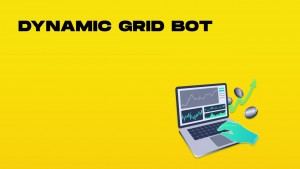Introduction to Grid Trading
Grid trading is a popular trading strategy that involves dividing a price range into multiple levels or “grids” to buy and sell assets. This approach allows traders to capitalize on market volatility by buying low and selling high at different price points. Grid trading can be applied to various markets, including cryptocurrency, stock, and forex markets. The strategy is versatile and can be used by traders with different trading styles and risk tolerance.
What Are Dynamic Grid Bots?
Unlike static grid bots that maintain fixed price ranges and order sizes, dynamic grid bots are part of an automated grid trading strategy that activates buy and sell positions at predefined price levels. They automatically adjust their parameters based on market conditions. They’re designed to thrive in both sideways and trending markets without requiring constant manual interventions.
Key Differences From Traditional Grid Bots
|
Traditional Grid Bots |
Dynamic Grid Bots |
|---|---|
|
Fixed price ranges |
Adaptive price ranges that move with the market |
|
Equal grid spacing |
Variable grid spacing based on volatility |
|
Require manual resets when price moves outside range |
Automatically follow price trends |
|
Optimal in sideways markets only |
Perform in both sideways and trending markets |
Key Features of Grid Bots
Grid trading bots are automated tools that execute trades based on predefined rules and parameters. They offer several key features, including real-time monitoring, custom strategies, and risk management tools. Grid bots can be used to trade a variety of assets, including cryptocurrencies, stocks, and forex pairs. They can also be customized to fit individual trading strategies and risk tolerance. Some advanced grid bots can dynamically adjust the grid according to market conditions, allowing traders to optimize their trading performance.
How Dynamic Grid Bots Work
Dynamic grid bots employ sophisticated algorithms to:
-
Continuously monitor market trends and volatility
-
Automatically shift the grid’s price range to follow the market
-
Adjust grid spacing based on observed volatility
-
Optimize order sizes to capitalize on changing market conditions
An infinity grid bot is an advanced trading robot specifically designed for cryptocurrency markets, featuring a grid of buy and sell orders that dynamically adjusts based on market movements.
When prices trend upward, the bot shifts its grid upward as well, maintaining buy orders below current price and sell orders above. This creates a “floating grid” that moves with the market rather than becoming obsolete when prices change dramatically.
The Technical Mechanics
Dynamic grid bots typically analyze several technical indicators including:
-
Moving averages to identify trends
-
Bollinger Bands to measure volatility
-
RSI (Relative Strength Index) to detect potential reversals
-
Volume data to confirm trend strength
-
Historical data to optimize and backtest trading strategies, model performance, evaluate past effectiveness, and develop informed risk management techniques
Based on these inputs, the bot continually recalculates optimal grid positions, spacing, and order sizes—sometimes making adjustments every few minutes in highly volatile markets.
Creating Grid Levels
Creating grid levels is an essential part of grid trading. Traders need to set a price range where the bot will operate and determine the entry point, trading volume, and take-profit percentage. The grid levels should be set based on market conditions and the trader’s strategy. In a sideways market, the price range might be set to capture frequent small price movements. In a trending market, the range might be adjusted to accommodate larger price swings.
Benefits of Dynamic Grid Bots
Switching to dynamic grids offers several advantages:
Dynamic grid bots can adapt to changing market conditions, making them more flexible and potentially more profitable than static grid bots. They can automatically adjust grid levels based on market volatility, ensuring that the trading strategy remains effective even in fluctuating markets. Additionally, dynamic grids can help in better risk management by adjusting the grid size and spacing according to the current market scenario.
Effective management of trading capital is crucial in this setup, as proper capital allocation and position sizing can significantly optimize the performance of grid trading bots.
Market Adaptability
Unlike traditional grids that fail when prices break range, dynamic bots follow the market in any direction. This means you won't miss out on prolonged trends or need to manually reset your strategy.
Volatility Optimization
By adjusting price intervals to match current volatility, dynamic bots place more orders during choppy markets (capturing more small movements) and fewer, wider-spaced orders during calmer periods.
Reduced Management Time
Once properly configured, dynamic bots require significantly less monitoring than traditional grid strategies, freeing you from constant parameter adjustments.
Improved Risk Management
Many dynamic grid bots include built-in stop-loss mechanisms and other risk management techniques that can automatically reduce position sizes or pause trading during extreme market conditions.
Potential Drawbacks
Despite their advantages, dynamic grid bots aren’t perfect:
-
Higher complexity - More sophisticated algorithms make troubleshooting challenging
-
Increased computational demands - May require more robust hosting or platform services
-
Higher trading fees - More frequent grid adjustments can lead to more transactions
-
Potential overtrading - Some bots may adjust too frequently in certain market conditions
-
Less predictable results - Performance can vary widely based on specific market characteristics, impacting the bot's performance
Setting Up a Dynamic Grid Bot
While each platform differs, setting up a dynamic grid bot typically involves:
-
Selecting a trading pair - Choose cryptocurrencies with sufficient liquidity and volatility
-
Configuring investment amount - Determine total capital allocation
-
Setting core parameters:
-
Initial price range width (as percentage)
-
Maximum allowable grid shift (to prevent runaway adjustments)
-
Volatility sensitivity (how quickly the bot responds to market changes)
-
Order size calculation method (equal value, decreasing, or increasing)
-
Configuring safety features - Stop-loss levels, maximum drawdown limits, etc.
-
Testing and launching - Start with smaller amounts until performance is verified
Integration with Cryptocurrency Exchanges
Grid trading bots can be integrated with various cryptocurrency exchanges, including Binance, KuCoin, and Bybit. This allows traders to access a wide range of trading pairs and liquidity. Exchange APIs often enable bots to execute trades directly on the platform, ensuring efficient and accurate trade execution without the need for manual intervention. Traders can choose the exchange that best suits their trading needs and integrate their grid trading bot with the exchange’s API.
Popular Dynamic Grid Bot Platforms
Several established crypto trading platforms now offer dynamic grid bot capabilities across various exchanges:
-
WunderTrading - Offers both DCA and grid bots with dynamic features
-
Bitsgap - Provides “smart” grid bots with market-following capabilities
-
Pionex - Features built-in dynamic grid options
-
Kucoin - Offers “Smart Rebalance” grid trading
-
Coinrule - Allows creation of custom rule-based dynamic grid strategies
Optimizing Performance
To maximize your dynamic grid bot results by choosing an effective trading approach:
Choose Appropriate Trading Pairs
Select assets with:
-
Sufficient daily trading volume (ideally >$1M daily) across multiple exchanges to optimize performance
-
Moderate to high volatility (10-50% monthly range)
-
No upcoming major events that could cause extreme price moves
Adjust Sensitivity to Market Conditions
Different market phases require different approaches to adapt to changing market dynamics:
-
In highly volatile markets: reduce sensitivity to prevent overtrading
-
In trending markets: increase maximum grid shift allowance
-
In range-bound markets: tighten grid spacing for more frequent trades
Start Small and Scale Gradually
Begin with 10-20% of your intended investment to validate the bot’s performance in current market conditions before committing more capital, ensuring it aligns with your trading goals.
Measuring Success
Evaluate your dynamic grid bot's performance using these metrics:
-
Net profit percentage - Total returns after fees
-
Win rate - Percentage of profitable grid positions
-
Maximum drawdown - Largest temporary decline from peak value
-
Grid utilization - Percentage of configured grid lines that actually executed trades
-
Comparison to buy-and-hold - Performance relative to simply holding the assets
Real-World Case Study
A Bitcoin/USDT dynamic grid bot set with moderate sensitivity and a 5% initial range during Q1 2023 delivered 12.3% returns over three months in live trading, outperforming both traditional grid strategies (7.6%) and buy-and-hold (9.1%) during the same period. The bot particularly excelled during mid-February when BTC experienced several sharp but short-lived price swings, allowing the dynamic grid to capitalize on the volatility while maintaining overall positioning during the broader uptrend.
Conclusion
Dynamic grid bots represent the evolution of grid trading strategy, combining the profit potential of traditional grids with adaptive mechanisms that keep your strategy relevant regardless of market direction. While they require more sophisticated setup and bring additional complexity, their ability to navigate volatile crypto markets with less manual intervention makes them worth considering for both novice and experienced traders.
As with any trading strategy, start with thorough research, small position sizes, and realistic expectations. Dynamic grid bots aren't magical profit machines, but rather sophisticated tools that—when properly configured—can help you systematically capture opportunities in the ever-changing cryptocurrency markets.
























